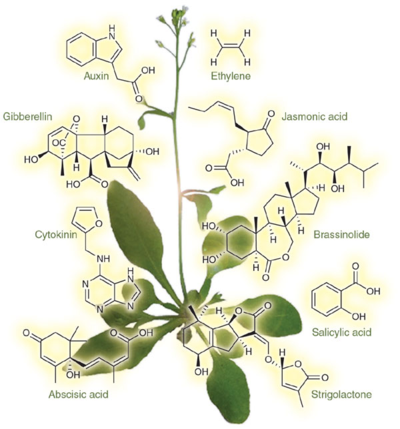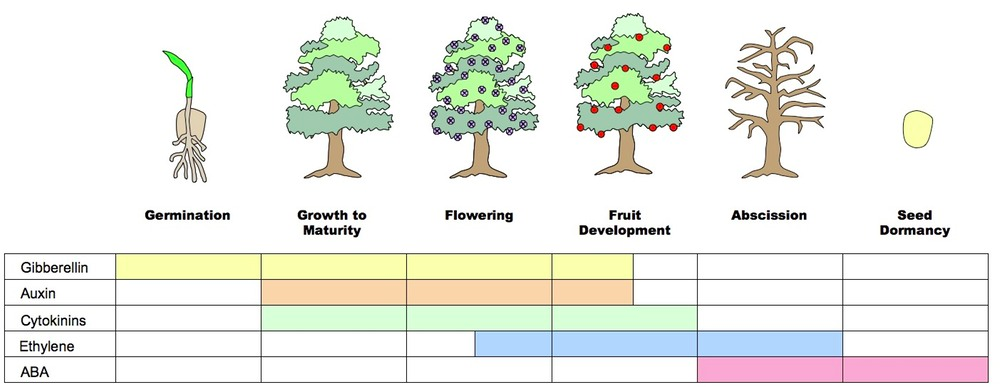Plant Hormones

Plant hormones are chemicals such as auxin that regulate plant growth. Plant hormones are signal molecules produced at specific locations in the plant, and occur in extremely low concentrations. The hormones cause altered processes in target cells locally and at other locations. They affect which tissues grow upward and which grow downward, leaf formation and stem growth, fruit development and ripening, plant longevity and even plant death. Hormones are vital to plant growth and, if they were to lack them, plants would be mostly a mass of undifferentiated cells.
In general, it is accepted that there are five major classes of plant hormones, some of which are made up of many different chemicals that can vary in structure from one plant to the next. The chemicals are each grouped together into one of these classes based on their structural similarities and on their effects on plant physiology. Each class has positive as well as inhibitory functions, and most often work in tandem with each other to regulate growth and other responses.
Abscisic acid (ABA)
Abscisic acid (also called ABA) is one of the most important plant growth regulators. In general, abscisic acid inhibits growth / germination. Abscisic acid induces bud and seed dormancy, preventing germination during winter. As summer approaches abscisic acid dissipates, but this occurs slowly and it takes some time for it's effects to wear off. This prevents seeds from germinating on warmer winter days and ensures they only germinate once the temperature is consistently warmer. Abscisic acid also preventing seeds from germinating within the fruit, slowing growth in more "mature" parts of the plant and closing stomata (tiny pores on the undersides of the leaves) in response to a lack of water.
Auxins (indole-3-acetic acid)
Auxins are produced in the shoot apical meristem (shoot tip) and stimulate cell growth & expansion (elongation). In general, auxins are a positive growth regulator. They stimulate development of xylem (tissues that transport water throughout the plant) and inhibit the growth of buds lower down the stems ensuring the plant grows from the leading tip (apical dominance). The very low concentrations of auxin that normally reach the roots generally promote root growth and branching. However, higher doses inhibit root cell growth and expansion (elongation).
Cytokinins (CK)
Cytokinins work together with auxin to promote growth and development, by promoting cell division and shoot formation. They are produced in the roots and travel. They counter the apical dominance induced by auxins, promoting the development of buds. In conjunction with ethylene they promote abscission (drop) of leaves and fruit.
Ethylene
Ethylene ("the ripening hormone") is a gas that promotes fruit ripening and abscission (drop) of leaves and fruit. Ethylene production increases when the seeds are mature, ensuring the fruit is released when only when the seeds are capable of germination. Fruit often releases ethylene gas as it ripens (this is why storing unripened fruit with a ripening apple will accelerate the ripening process). It also affects cell growth and cell shape; when a growing shoot hits an obstacle while underground, ethylene production greatly increases, preventing cell elongation and causing the stem to swell. The resulting thicker stem can exert more pressure against the object impeding its path to the surface. If the shoot does not reach the surface and the ethylene stimulus becomes prolonged, it affects the stem's natural geotropic response, which is to grow upright, allowing it to grow around an object.
Gibberellins
Gibberellins play an important role in germination, initiating the mobilisation of nutrients stored within the seed. Absorption of water by the seed causes production of GA. They also promote the elongation of stems, flowering and cell division (growth). Gibberellins also reverse the inhibition of shoot growth and seed dormancy induced by ABA.

Comments
Post a Comment